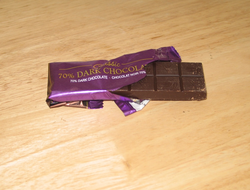Chocolate: a delicious route to health?
Published: February 07, 2020
Most chocolate is high in fat and sugar, macronutrients that make a significant contribution to your energy intake and potentially your fat stores.
This in turn may increase your risk for several chronic diseases.
However, studies also suggest that consuming chocolate may provide some health benefits
It is thought that flavanols (phytochemicals) contained in cocoa beans, from which chocolate is produced, may be associated with improved brain function, heart health, and maintenance of a healthy body weight.
However, research to date is inconclusive as to the beneficial health effects of consuming chocolate as part of an eating for health food plan.
Despite modern research chocolate, or more precisely cocoa, has a long history as a nourishing and pleasurable food item.
History of Cocoa
Cocoa powder which is used to produce chocolate and chocolate flavoured products is the non-fat portion of cocoa butter and is produced from cocoa beans.
Cocoa or cacoa beans grow in “football shaped pods” on the Theobroma cacao tree and have been cultivated for thousands of years. This “food of the Gods” was originally cultivated by the Mayan population of Mesoamerica almost 1800 years ago.
Wealthy Aztecs mixed cocoa with spices for a nourishing drink, offered chocolate to the gods, and used the beans for fighting tiredness and stomach upsets.
Cocoa was introduced into Europe in the 16th century where the chocolate drink was mixed with cane sugar, vanilla, cinnamon, and aniseed to remove the bitterness.
In France only the royal court was allowed to drink chocolate, but in 1657 London opened the first Chocolate house to the public.
As a result of high import taxes, chocolate only arrived in the US in the 19th century. Due to its natural antioxidant flava(o)noids chocolate was found to be spoilage resistant and was used as rations during the 1st World War.
Cocoa is very rich in flavanoids, the largest group of phytochemicals, but the amount of flavonoids in cocoa may vary due to farming methods, plant genetics, fermentation, roasting, and alkalisation procedures.
Flava(o)noids, as flavanols, are stored in the anthrocyanin pigment and compose 14 -20% of total bean weight. Pod storage, pulp pre-conditioning, pH, titrable acidity and temperature all affect flavanol quality.
There are higher levels of flavanoids in dark chocolate than light chocolate and none in white chocolate. The two principle flavanols in cocoa are epicatechin and catechin with epicatechin accounting for about 58% and catechins 37% of total flavanoids.
Flavanoids have antioxidant properties and are thought to influence several enzyme...link to the full article to learn more.
References
1.
Whitney, E. & Rady Rolfes, S. (2005). Understanding Nutrition. Belmont, CA: Thomson Wadsworth
2.
CSPI March 2015, CSPI April 2015, CSP January/February 2016, CSPI December 2013, CSPI 2008, March 2008, CSPI 2012
3.
Innes AJ, Kennedy G, McLaren M, Bancroft AJ, Belch JJF. Dark chocolate inhibits platelet aggregation in healthy volunteers. Platelets. 2003 08//;14(5):325.
4.
Engler, M. B., & Engler, M. M. (2006). The emerging role of flavonoid-rich cocoa and chocolate in cardiovascular health and disease. Nutrition Reviews, 64(3), 109-118.
5.
Nazaruddin, Seng, L.K. Hassan,Said,. (2006). Effect of pulp preconditioning on the content of polyphenols in cocoa beans (theobroma cacao) during fermentation. Industrial Crops and Products, 24(1), 87
6.
Pearson, D. A., Holt, R. R., Rein, D., Paglieroni, T., Schmitz, H. H., & Keen, C. L. (2005). Flavanols and platelet reactivity. Clinical & Developmental Immunology, 12(1), 1-9.

